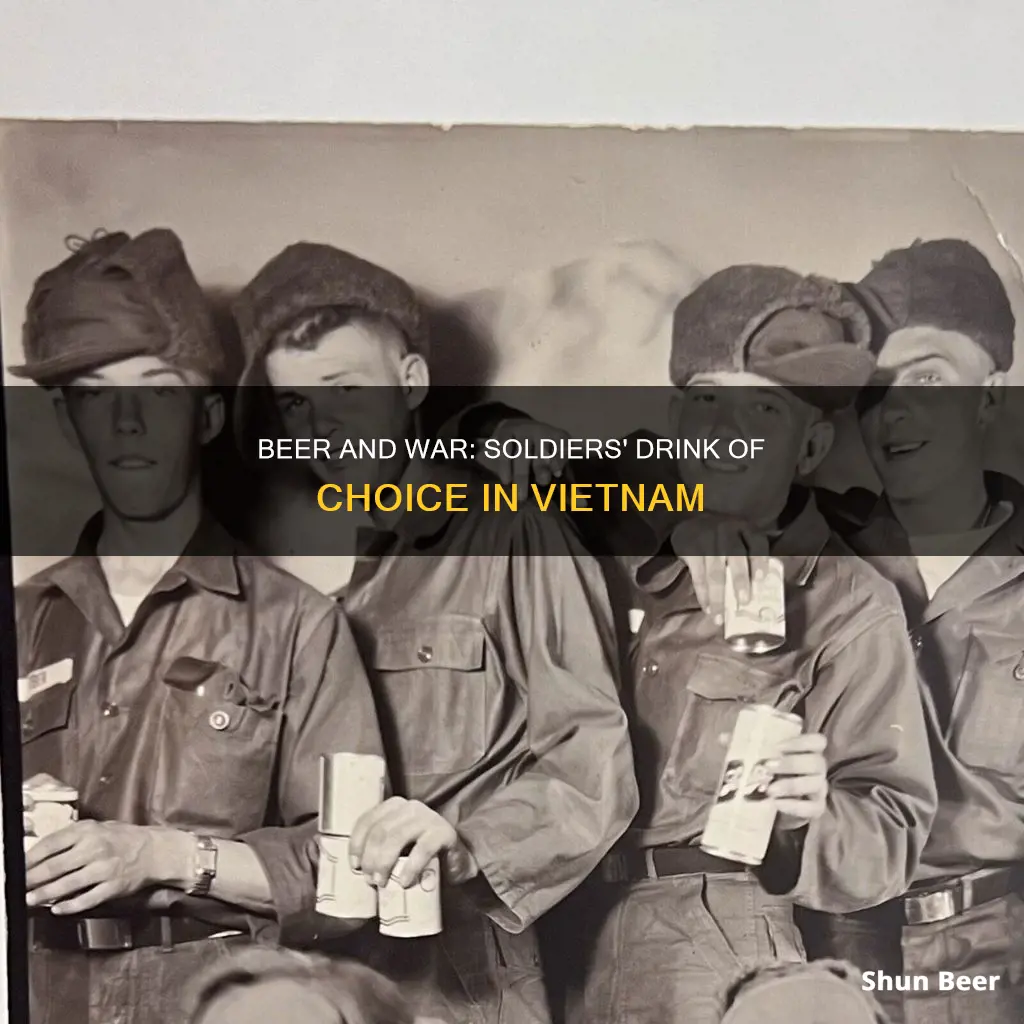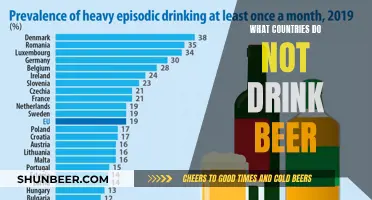
During the Vietnam War, beer was a common beverage for soldiers, with various American and local Vietnamese beer brands available. The presence of beer provided a sense of comfort and a taste of home for the troops, who often consumed it at recreational facilities or while relaxing after a hard day of work. The availability of beer also served as a break from the hardships and dangers of combat, contributing to the overall culture and morale of the troops.
| Characteristics | Values |
|---|---|
| Beer brands available | Pabst Blue Ribbon, Carling Black Label, Budweiser, Ballantine’s, Biere “33” (or “Ba mui ba”), Tiger Beer (Biere Larue), Foster’s Lager, Reschs, San Miguel, Schlitz, Falstaff |
| Beer can type | Old style (pre-“pop top”) cans that required a can-opener ("church key") |
| Local beer taste | Inconsistent quality, some bottles tasted bitter, some like formaldehyde, and even vinegar |
| Beer consumption locations | Bars, clubs, retail stores, military Post Exchange (PX), firebases, etc. |
| Beer cost | A can of beer cost a GI around 15 cents |
| Beer consumption quantity | 500,000 U.S. forces in Vietnam consumed close to 32 million cans of beer a month |
| Beer storage methods | Half fridges, clay water tubs filled with ice, etc. |
What You'll Learn
- Beer was a welcome break from the hardships of war
- Pabst Blue Ribbon, Budweiser, and Carling Black Label were some of the American beers available
- Local Vietnamese beers included Ba Moui Ba and Tiger Beer
- Beer was shipped to even the most remote firebases
- Beer cans had flat tops and required a church key to open

Beer was a welcome break from the hardships of war
For troops in the field, beer was often beyond reach while on patrol. However, even at the most remote firebases, beer was shipped in with the rest of the unit's supplies. American beer companies donated enough beer to ensure a ration for every troop. Some units would knock back a cold one as they cleaned their weapons after a mission. Others locked up the beer until a designated day when they could let loose. Some units even pooled their funds to buy more beer during resupply missions.
The taste of home was important to the troops, and the canning process played a significant role in getting beer to the troops. The can blocked out light, preventing the beer from going bad, and made shipping more efficient. The miracle of modern technology allowed popular American beers like Budweiser, Miller, Schlitz, PBR, and Carling Black Label to be enjoyed by troops in Vietnam.
The consumption of beer provided a sense of continuity for the Vietnam veterans when they returned home. Even today, they can buy the same beers that offered them a brief respite from the hardships of war.
Beer and Fitness: Can You Drink and Still Get Ripped?
You may want to see also

Pabst Blue Ribbon, Budweiser, and Carling Black Label were some of the American beers available
Pabst Blue Ribbon, or PBR, is a beer brand that has been around for a long time and is known for its iconic blue ribbon on the label. It has a strong connection to American culture and has become a symbol of heritage and tradition. The brand has a strong following and is known for its music festivals and local culture celebrations.
Budweiser, introduced in 1876, is an American-style pale lager and one of the largest-selling beer companies in the United States. It is brewed with a combination of rice, hops, and barley malt, resulting in a filtered beer available on draft, in bottles, and cans. Budweiser has a strong presence in advertising and sports sponsorships, further contributing to its popularity.
Carling Black Label, brewed in Canada since 1926, is a light blond lager with a clean taste and a subtle hint of hops. It is known for its slow fermentation process and the use of top-quality ingredients, contributing to its smooth and refreshing flavor profile.
These beers, among others, were likely a familiar taste of home for American soldiers serving in Vietnam and provided a sense of comfort and camaraderie during their time in a foreign land. They may have been a source of solace after long days and a way to unwind and socialize with fellow troops.
Drinking Beer While Riding: Virginia's Law for Passengers
You may want to see also

Local Vietnamese beers included Ba Moui Ba and Tiger Beer
During the Vietnam War, American soldiers had access to a variety of beers, including local Vietnamese brews. Two of the local beers were Ba Moui Ba (Biere "33") and Tiger Beer (Biere Larue).
Ba Moui Ba, also known as Biere "33", was a popular beer among American GIs during the Vietnam War. The name "Ba Moui Ba" translates to "thirty-three" in Vietnamese, which was derived from its original 33-centilitre (11.2-ounce) bottles from the early 1900s. The beer originated in France, using a German recipe and ingredients, and later moved its production to Saigon (now Ho Chi Minh City). After the fall of South Vietnam in 1975, the communist government changed the name to "333 Premium Export Beer" to distance itself from its colonial origins. Today, it is still brewed in Vietnam by Sabeco Brewery and is available in several countries, including the United States, Canada, and Australia.
Tiger Beer, on the other hand, was a Singaporean brand of beer launched in 1932. It is a 5% ABV bottled pale lager and is currently produced by Heineken Asia Pacific. During the Vietnam War, Tiger Beer was available in Vietnam and was considered a local beer by American soldiers. However, the quality of Tiger Beer was inconsistent, with some bottles tasting bitter or like formaldehyde. Despite this, it was still a popular choice among the troops. Today, Tiger Beer is available in more than 60 countries worldwide and continues to be a well-known brand.
Both Ba Moui Ba and Tiger Beer provided a taste of home and a break from the hardships of war for American soldiers serving in Vietnam. They were widely consumed and played a role in the soldiers' downtime, offering a sense of comfort and normalcy in a challenging environment.
Dancing and Drinking Beer: A Perfect Pair?
You may want to see also

Beer was shipped to even the most remote firebases
During the Vietnam War, beer was a welcome break from the hardships of combat for US soldiers. While troops on patrol often had to go without, beer was shipped to even the most remote firebases, along with the rest of a unit's supplies. The stifling humidity of Vietnam made cold beer all the more appealing to troops.
The US military's adaptability meant that even frontline troops could get their hands on some chilled beer with a little planning. Support units at major logistics hubs, such as Long Binh, could simply purchase a fridge to keep their beer cool. Combat units, on the other hand, had to be more resourceful. They might requisition a clay water tub from the local economy and trade with locals for ice to create an improvised cooler.
American beer companies donated enough beer to ensure a ration for every troop. Each unit had its own method for distributing the beer. Some units would knock back a PBR or Schlitz after a mission while cleaning their weapons. Other units locked up the beer until a designated day when they could let loose. Some units even pooled their funds to purchase additional beer during resupply missions.
The ability to drink a cold beer was a comfort of home for soldiers in Vietnam, and the military's vast logistics network ensured that even those in remote firebases could enjoy this simple pleasure.
Beer and Percocet: A Risky Mix?
You may want to see also

Beer cans had flat tops and required a church key to open
During the Vietnam War, beer was a welcome break from the hardships of combat. American beer brands like Pabst Blue Ribbon, Carling Black Label, Budweiser, and Ballantine's were available to soldiers. However, the beer cans they received were the old-style pre-"pop-top" cans with flat tops, requiring a can opener, also known as a "church key", to open them. This was despite the fact that "pop-top" cans had already been in widespread use in the US for several years.
The reason for this discrepancy is speculated to be transportation-related, as there may have been challenges with shipping "pop-top" cans across the Pacific by ship. As a result, soldiers had to rely on their "church keys" to puncture the flat tops of the beer cans and enjoy their beverage.
The "church key" can opener was a small piece of steel that allowed drinkers to open the flat-top cans. The cans themselves were made of steel initially and then transitioned to aluminum in 1958, but the flat-top design persisted. It wasn't until after the Vietnam War that canned beers in the US gained the "pop-top" feature that we know today.
The "church key" and flat-top can combination was a small price to pay to ensure that US service members could enjoy a taste of home, even in the remote jungles of Vietnam.
Beer and Naproxen: Safe Mix or Health Risk?
You may want to see also
Frequently asked questions
Yes, soldiers drank beer in Vietnam.
Soldiers drank American beer brands like Pabst Blue Ribbon, Budweiser, and Carling Black Label. They also drank local Vietnamese beers like "Ba Moui Ba" (Biere "33") and Tiger Beer (Biere Larue).
Support units could buy a fridge to keep their beer chilled. Combat units might requisition a clay water tub from the local economy and barter with locals for ice.
Beer was canned, which made it easier to stack, store, and ship. Despite the challenges of canning beer due to carbonation and metal interaction, the cans ensured that the beer stayed fresh and protected from light.
Beer provided a taste of home and a sense of continuity for the soldiers. It was a way to relax and unwind after a hard day, and it helped to boost morale, especially in the harsh conditions of the Vietnam War.







